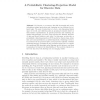584 search results - page 56 / 117 » Reinforcement Learning Task Clustering |
NIPS
1992
13 years 10 months ago
1992
How can artificial neural nets generalize better from fewer examples? In order to generalize successfully, neural network learning methods typically require large training data se...
IJCNN
2006
IEEE
14 years 2 months ago
2006
IEEE
— Delegating the coordination role to proxy agents can improve the overall outcome of the task at the expense of cognitive overload due to switching subtasks. Stability and commi...
ROBOCUP
2000
Springer
14 years 10 days ago
2000
Springer
Q-learning, a most widely used reinforcement learning method, normally needs well-defined quantized state and action spaces to converge. This makes it difficult to be applied to re...
PKDD
2005
Springer
14 years 2 months ago
2005
Springer
For discrete co-occurrence data like documents and words, calculating optimal projections and clustering are two different but related tasks. The goal of projection is to find a ...
NIPS
2008
13 years 10 months ago
2008
We use graphical models and structure learning to explore how people learn policies in sequential decision making tasks. Studies of sequential decision-making in humans frequently...

